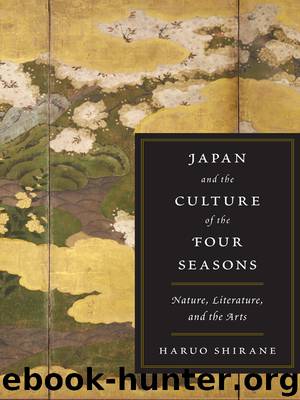Japan and the Culture of the Four Seasons by Shirane Haruo

Author:Shirane, Haruo
Language: eng
Format: epub
Tags: LIT008000, Literary Criticism/Asian/General, ART000000, Art/General
Publisher: Columbia University Press
Published: 2012-03-19T16:00:00+00:00
FIGURE 21
DOLL’S FESTIVAL AND IKEBANA
This “portrait of a beautiful person” (biiinga) in Chōbunsai Eishi’s series “Elegant Five Sacred Festivals” (Fūryū gosekku, ca. 1794–1795) exemplifies the ways in which an annual observance (Peach Day, also known as the Doll’s Festival [third day of the Third Month]) combines nature (white peach flowers, a prayer for immortality, in ikebana form) with the rituals of the observance (doll making). (Color woodblock print [signed Eishi zu]; vertical ōban, 14.8 × 9.9 inches. Courtesy of the Museum of Fine Arts, Boston, William S. and John T. Spaulding Collection, 1921, no. 21.4905)
The most prominent summer observance in the Heian period was the fifth day of the Fifth Month, better known today as the Tango Festival,18 which was originally a ritual for dispelling evil influences. From the early eighth century, plants with strong scents, such as sweet flag (shōbu) and mugwort (yomogi), were placed close to the body, in the hair, and in the eaves and on the roofs of houses to ward off evil. With the addition of the custom of drinking sweet-flag wine and bathing in sweet-flag water, this practice continued into the Edo period. As an expression of thanks to his host who gave him sandals (waraji) as a farewell present, Bashō wrote this hokku in Oku no hosomichi (Journey to the Deep North, ca. 1694): “Grass of the sweet flag—I shall use them to tie my straw sandals” (Ayamegusa ashi no musuban waraji no o). Unlike city dwellers, who put sweet flag in the eaves of their homes, the traveler, in a haikai twist, places them on his sandals, making travel his dwelling. In the Heian period, the Tango Festival was celebrated at the imperial court with sweet flag (which closely resembles the iris) and medicine balls (kusudama) made of incense and decorated threads.19 Horseback archery and horse racing took place at the court on the fifth and sixth days of the Fifth Month, followed by a banquet.20 The word shōbu (sweet flag) was a homonym for shōbu (; literally, “honoring the warrior”), and in the medieval period (1185–1599), the Tango Festival became a day for boys to display their martial talents.21
The Star Festival, a major topic in kanshi (Chinese-style poetry) and waka (classical poetry), was held on the seventh day of the Seventh Month, at the beginning of autumn. Tanabata was derived from Kikōden, a Chinese annual observance imported to Japan and first celebrated at the imperial court in 755. According to the Chinese legend, two stars—the Herdsman (Kengyū [Altair]) and the Weaver Woman (Shokujo [Vega])—were lovers, but were punished for a transgression and separated by the Milky Way (Ama-no-gawa). On the seventh day of the Seventh Month, the two stars were allowed to meet for one night only, and on this day women prayed to improve their skills in weaving and sewing. In ancient China, the Herdsman was associated with agriculture, and the Weaver Woman with sericulture, thread, and needle. By the Six Dynasties period (220–589) in China, the custom had developed
Download
This site does not store any files on its server. We only index and link to content provided by other sites. Please contact the content providers to delete copyright contents if any and email us, we'll remove relevant links or contents immediately.
| African | Asian |
| Australian & Oceanian | Canadian |
| Caribbean & Latin American | European |
| Jewish | Middle Eastern |
| Russian | United States |
4 3 2 1: A Novel by Paul Auster(12281)
The handmaid's tale by Margaret Atwood(7678)
Giovanni's Room by James Baldwin(7189)
Asking the Right Questions: A Guide to Critical Thinking by M. Neil Browne & Stuart M. Keeley(5632)
Big Magic: Creative Living Beyond Fear by Elizabeth Gilbert(5610)
Ego Is the Enemy by Ryan Holiday(5292)
The Body: A Guide for Occupants by Bill Bryson(4974)
On Writing A Memoir of the Craft by Stephen King(4863)
Ken Follett - World without end by Ken Follett(4643)
Adulting by Kelly Williams Brown(4486)
Bluets by Maggie Nelson(4472)
Eat That Frog! by Brian Tracy(4432)
Guilty Pleasures by Laurell K Hamilton(4358)
The Poetry of Pablo Neruda by Pablo Neruda(4038)
Alive: The Story of the Andes Survivors by Piers Paul Read(3967)
White Noise - A Novel by Don DeLillo(3953)
Fingerprints of the Gods by Graham Hancock(3940)
The Book of Joy by Dalai Lama(3899)
The Bookshop by Penelope Fitzgerald(3775)
